Over the past two summers, I’ve come across some cars and series that were struggling for participation. Last summer, the Radical Racing Challenge often managed just one official race per week, and this year, I found that both the Kia Optima and Pontiac Solstice had sparse turnouts in their respective multi-class series.
For every struggling series, though, I found small ones that were thriving. The Lotus 49 and Kamel GT series have limited interest but both manage weekly broadcasted races.
If those series with tricky historical cars can survive in iRacing’s sea of road racing content, then I figured anything could.
But then I saw the current state of the Fanatec GT Challenge, and for the first time in 17 weeks of my Summer Road Trips, I had no place to race.
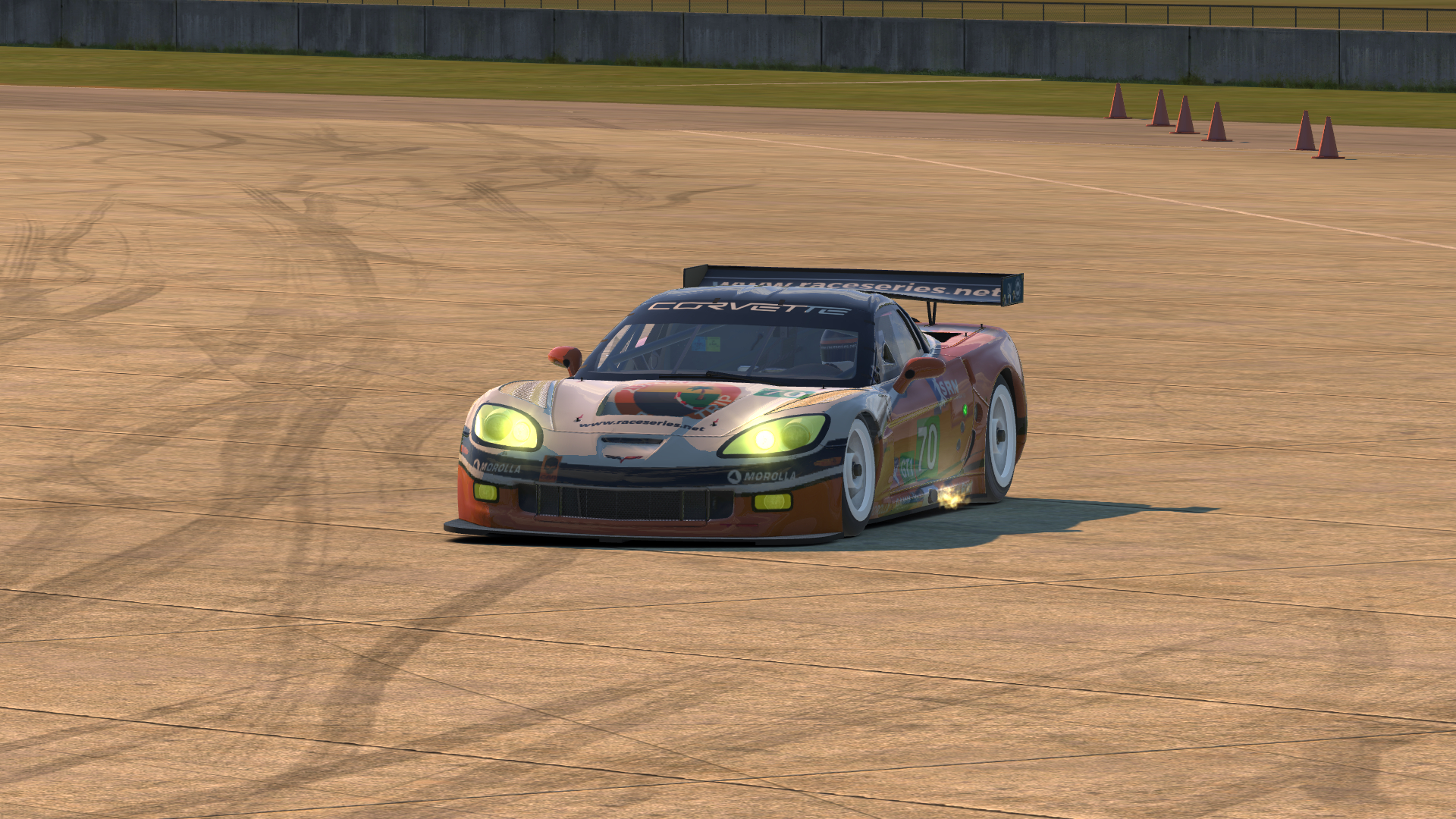
All by myself on the track this week.
The three cars in this series — the GT1 Corvette C6R and Aston Martin DBR9, plus the Ford GT2 — have always had something of an identity crisis, moving from one series to another in both single-class and multi-class settings. But now, they seem to have no identity whatsoever because almost no one is driving them.
While my goal this week had originally been to try to tame the Corvette, which I’d never quite gotten the hang of, I quickly realized that my job would turn to one of damage assessment, or perhaps even autopsy since this series was nearly dead on arrival.
Despite a modest start to the season with a handful of official races in week 1 at Watkins Glen, participation quickly declined. Week 2 had just one official race with the bare minimum of 8 drivers, and there have been no official races in the three weeks since then, including last week at Sebring.
Against the Clock
Even though I couldn’t find an official race, I didn’t want that to stop me from driving altogether. So instead of racing, I opted for a discipline that I hadn’t driven in years but used to run quite frequently — time trials.
While it may not have the wheel-to-wheel excitement of a race, time trialing still offers driver-to-driver competition as measured by the stopwatch. It’s got the intensity of qualifying stretched out over a 30-minute session, and the pressure of running a clean, consistent pace lap after lap is a great training exercise for any driver.
I used to run time trials nearly every season, often in multiple cars. In fact, I even won an overall time trial championship in the Ruf CSpec, as well as recording as many overall and divisional top-three finishes in both road and oval series.
Time trials can be extremely rewarding when you’re comfortable and on pace, but they can also be frustrating when you’re not. One week in the NASCAR truck at Bristol, I couldn’t seem to complete 10 consecutive laps without hitting the wall, which left a mark on my safety rating despite never driving around another car.
In that sense, I thought a time trial session last week would be good practice in the Corvette, even if it put me slightly outside my comfort zone. If I could complete a full run of four consecutive laps around Sebring, then I would at least feel like I had made some progress in that car, which always felt a bit too overpowered and unpredictable to me.
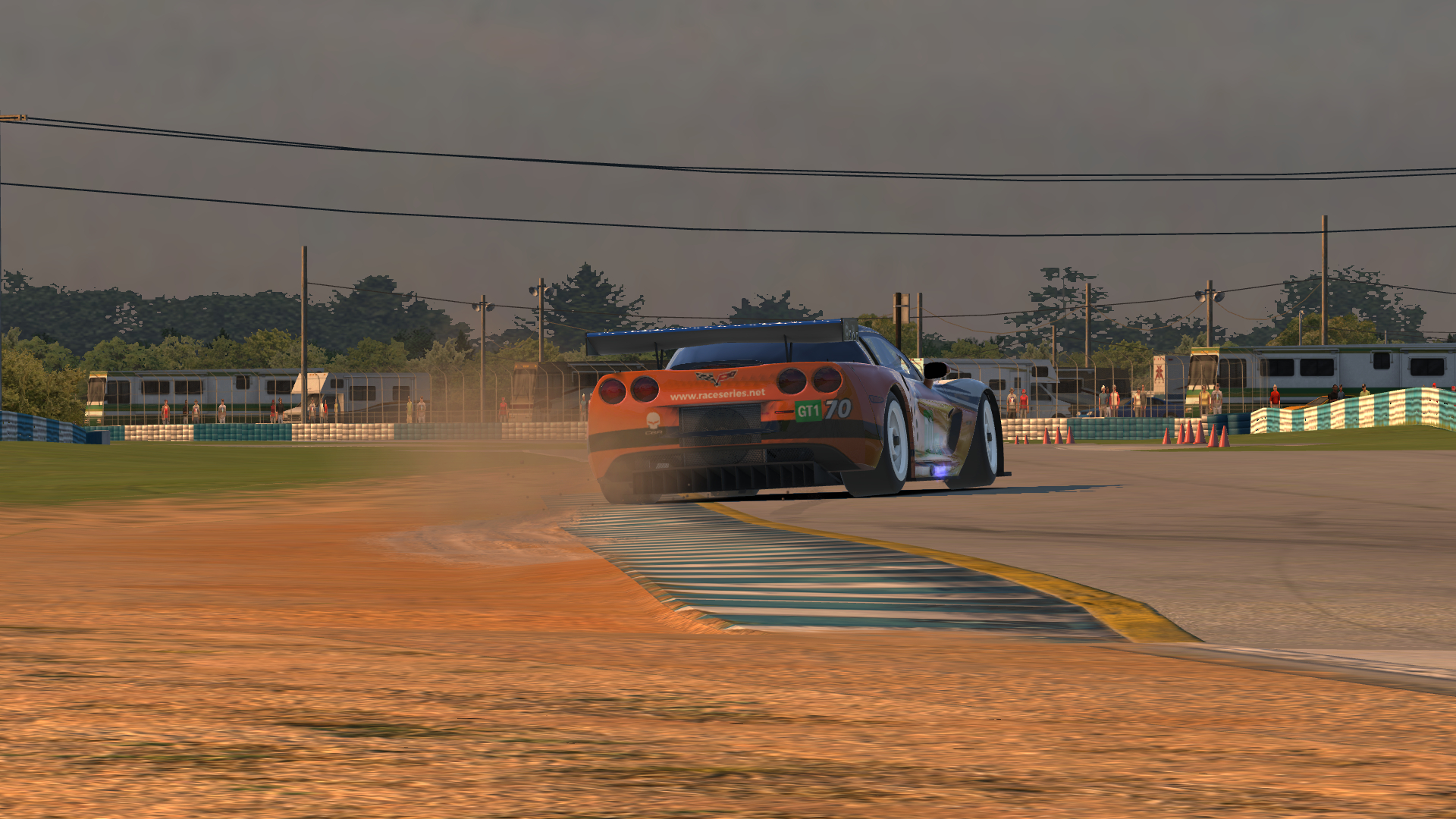
Getting sideways in the Corvette on corner exit.
My first attempt started well, with two solid and clean laps. But I started pushing on lap 3 and ran off course in the middle of the lap, invalidating the run.
In my next attempt, I didn’t even finish the first lap before taking an off-track penalty. By that point, it was already 10 minutes into session, so I would need to clean up my driving if I hoped to record any four-lap runs.
My third attempt started with three clean laps, but at the beginning of my fourth, I dropped a tire onto the dirt exiting turn 1. For my final run, I knew I had to be a bit more cautious on corner exit since it was my main trouble spot in this car.
I ran my two fastest laps of the week to begin that attempt, then stopped pushing quite as hard for the final two laps. I lost a couple tenths on lap 3 and a couple more on lap 4 when I nearly spun putting the power down exiting Tower corner. However, I still finished with a solid four-lap average of under 1 minute 55 seconds, which wound up being the fastest of the week among nine drivers who made time trial attempts in the GT1 class.
No, 30 minutes of lapping all alone wasn’t as exciting as being in a race, but given the empty sessions in this series, I had to take what I could get.
Fanatec GT Challenge - Time Trial
Thursday, July 12 at 5:42 pm EDT| Ranking | Fastest 4 Lap Average | Fastest Lap | Incidents | TTRating | Safety Rating |
|---|---|---|---|---|---|
| 1 | 1:54.918 | 1:54.671 | 3 | 2212 (+14) | A 4.61 (-0.01) |
Given the Runaround
To better understand the precarious position this series is in, it may be worthwhile to understand the history of its cars. The GT1 and GT2 classes were part of real-world endurance championships from 2005 through 2010, before GT1s were retired from competition and GT2s gave way to the modern GTE class.
The Corvette was iRacing’s first GT car, so it originally ran in a standalone series as well as multi-class races whenever a GT was needed. In the first Petit Le Mans race, for instance, the Corvette ran alongside the Ford Mustang FR500S.
When iRacing added the HPD prototype and Ford GT2 in 2011, the Corvette became the middle class in the Prototype/GT Challenge series, which was once wildly popular and extremely competitive.
The poor driving standards of some HPD drivers eventually discouraged GT drivers like myself, so the HPD was then quarantined in its own single-class series while the Corvette and Ford formed the first incarnation of the GT Challenge Series, later joined by the McLaren MP4-12C GT3 car as well.
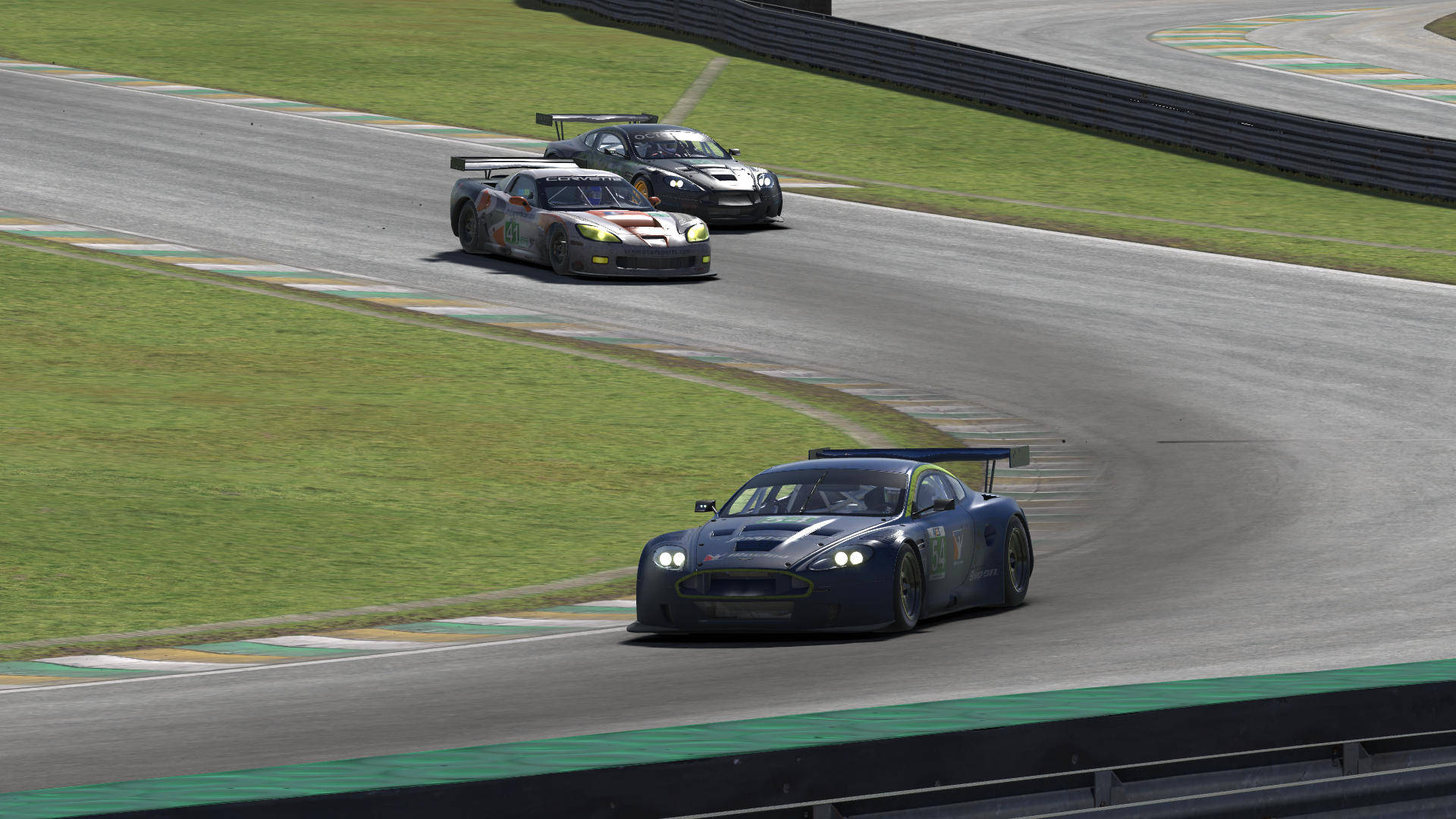
A close battle between GT1 cars.
When iRacing added the Aston Martin in 2015, it ran with the Corvette in their own single-class GT1 World Championship series for 4 seasons while the Ford became part of the IMSA series along with the HPD, the Riley Daytona Prototype, and the Ruf CSpec.
As iRacing’s version of a modern-day endurance racing car lineup continued to take shape, members begged for a reincarnation of the original Proto/GT series with the Aston Martin added. However, the actual participation fell short of the demand, and the new series never reached its previous levels of popularity.
Finally, with iRacing’s addition of two LMP1 cars earlier this year, Proto/GT was dissolved, the HPD joined the LMP1s and GTEs in the new iRacing Le Mans Series, and the leftovers — the GT1s and Ford GT2 — were left to re-form the GT Challenge series.
Last season, that series found a solid footing thanks to iRacing credits offered to divisional champions and a weekly strength-of-field race organized by one team. But that team shifted its focus to a different car — the Radical — for this season, and in any case, it’s not fair to ask a single team or league to fully bear the burden of keeping a struggling series afloat.
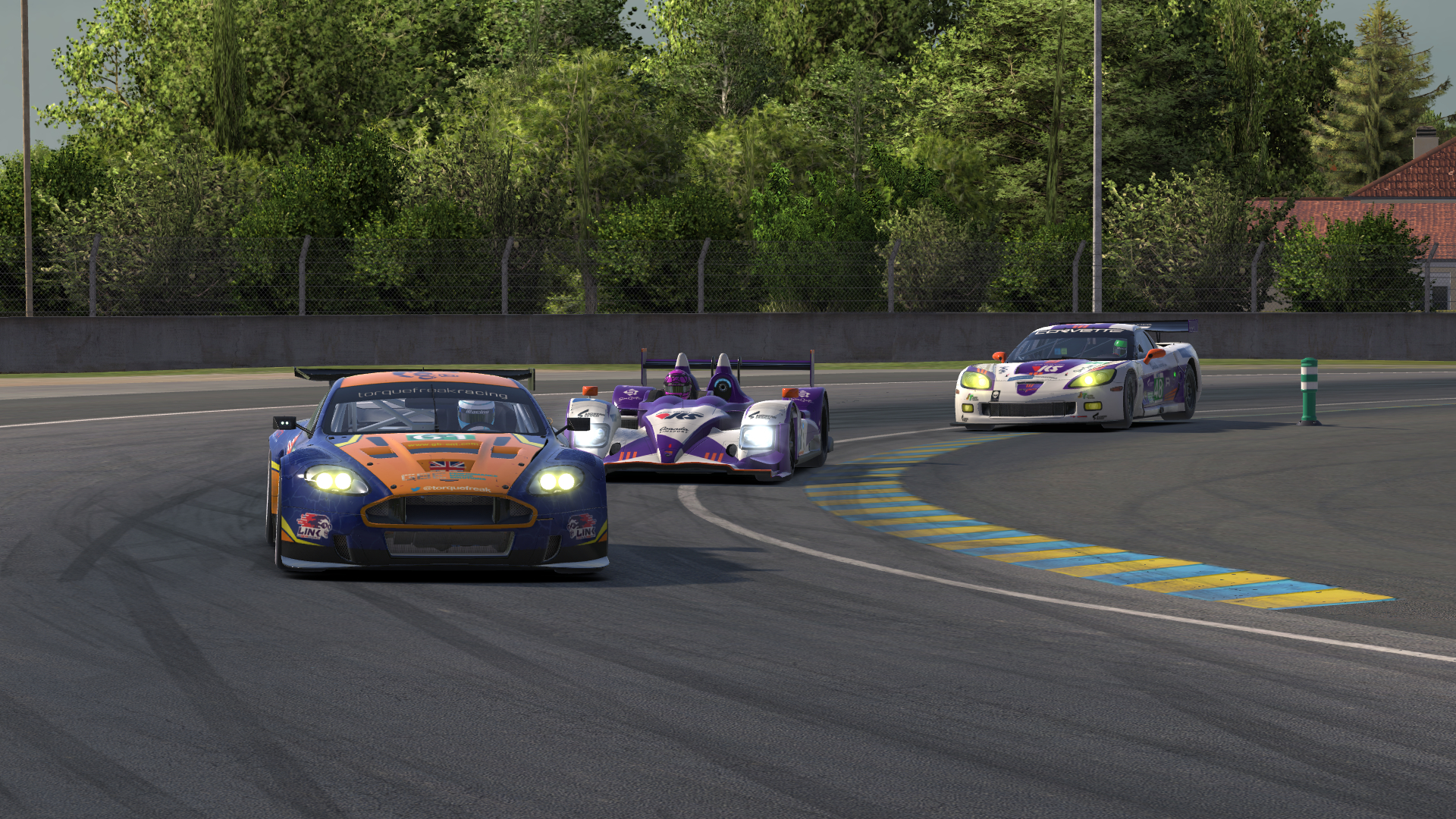
HPDs and GT1s on track together in the NEO Endurance Series.
Perhaps the nomadic nature of the cars in this series is at least partially to blame for its current issues. Back when they were part of Proto/GT, the stronger participation of the HPD was generally enough to make races go official even when there weren’t many GT cars.
Now that they’re on their own, they’re in a worst-of-both-worlds scenario. Like the Kia and Solstice I drove earlier this season, GT1 and GT2 cars are now outdated, and we have their replacements — the newer, easier, and arguably more fun GTE cars — on iRacing in a separate series.
While my week in the Ruf Track car showed me that some off-brand products can be almost as good as the name brands, why would you choose a product past its expiration date when something newer and fresher is available?
Ideas Abound
This season, there hasn’t been much activity in the subforums for the GT Challenge series or its individual car classes. Although weekly race threads continue to be posted, there seems to be almost no other interest or organization.
However, that doesn’t mean the overall iRacing community hasn’t taken notice of the plight of this series. In the past few weeks, threads have been posted in the general discussion forum with titles like “GT1/2 hasn’t gone official since June 17th” and “GT dead?”.
In those threads, dozens of members have debated the source of the problem and possible solutions. Although it’s said that there are no bad ideas, I can’t say that I’ve seen many good ones in those discussions either.
The first suggestion I saw was, in some ways, the death penalty: retiring the GT1 and GT2 cars from official competition altogether. It wouldn’t be unprecedented, as iRacing has traditionally removed cars like the old Daytona Prototype and V8 Supercars once newer versions have become available.
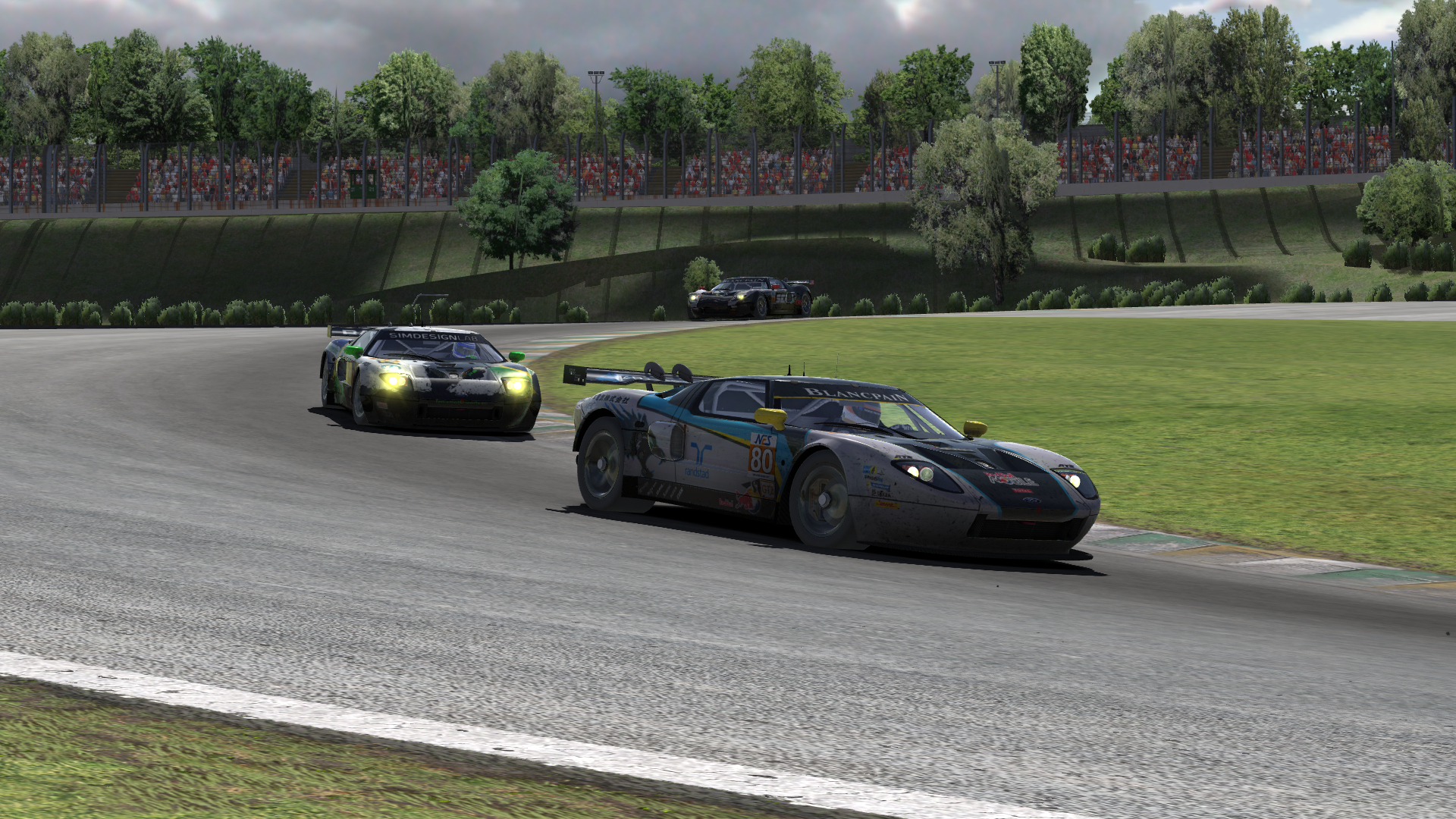
A pack of Ford GT2s — a rare occurrence on iRacing nowadays.
With the impending addition of AI racing, likely coming to iRacing by the end of the year, older cars like these could be left to leagues and offline AI competition, where computerized drivers are far less likely to jump ship into GTE cars.
This isn’t a terrible idea and it will likely need to be implemented for some cars at some point, but I’m not ready to give up on the older GT cars just yet.
Another school of thought says that iRacing simply needs to recruit more members and all the new ones will disperse among the less popular series. Of course, the reality is that new members are likely to go where the existing ones are. Unless throngs of people from the Corvette or Aston Martin fan clubs join in, it’s unlikely that even doubling the current amount of iRacing members would significantly help the situation in the GT Challenge series.
One popular idea takes a page out of iRacing’s book for the Radical SR8, making this troubled trio part of the service’s free content. On the surface, it’s not a bad suggestion. Since new drivers aren’t likely to pay for an obsolete product and the cars probably aren’t selling well anyway, they might as well just make them available to everyone.
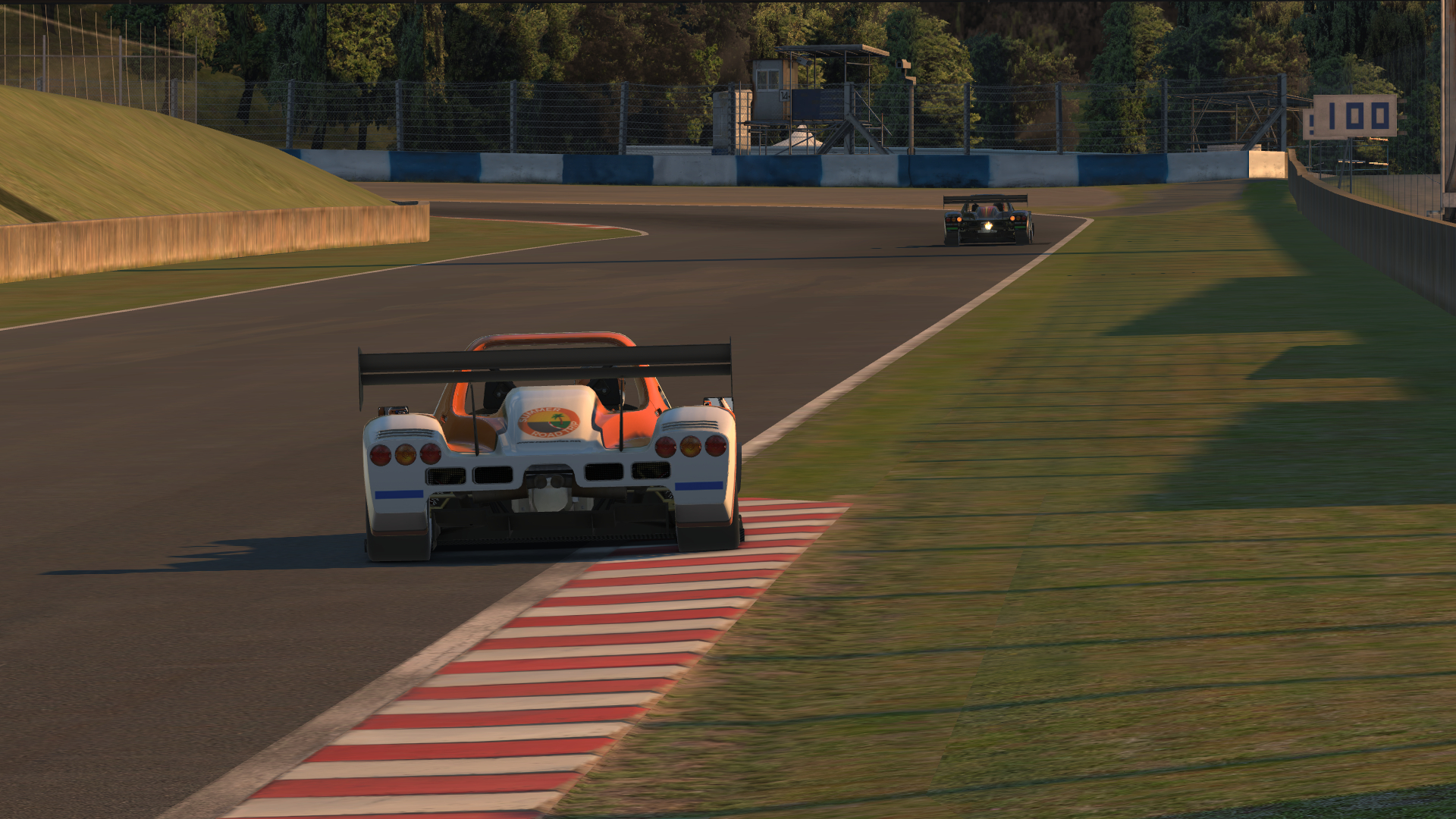
The Radical SR8 — a prototype for how to revive a struggling series?
There are a few potential issues with this. The first, as one member pointed out, is a potential contractual one. iRacing’s deals with Aston Martin, Chevrolet, and Ford may prohibit them from offering the car for free, regardless of how bad sales are.
In addition, while making the Radical free has worked well so far, it is sporty, maneuverable, and seems largely ageless. By comparison, the GT1 and GT2 cars can be cumbersome to drive and are clearly outdated. Even if they’re free cars, why would people drive them when they could race in the more modern and more popular IMSA, Le Mans, or GT3 series?
One proposed answer to this problem is to restructure iRacing’s multi-class road racing ladder. Under this proposal, the Le Mans series would be moved to the A-class level, the IMSA series would move to B class, and a new series combining the free GT1s, GT2, and old Riley Daytona Prototype would join Kamel GT at the C-class level.
While this idea has gained quite a bit of traction on the forums, I see several holes in it. For one, license class isn’t usually a major hurdle toward participation. If a C-class driver wants to race IMSA badly enough, it’s not too difficult for them to raise their license in the span of a week or two, and it’s hard to imagine them simply settling for whatever C-class series are available instead.
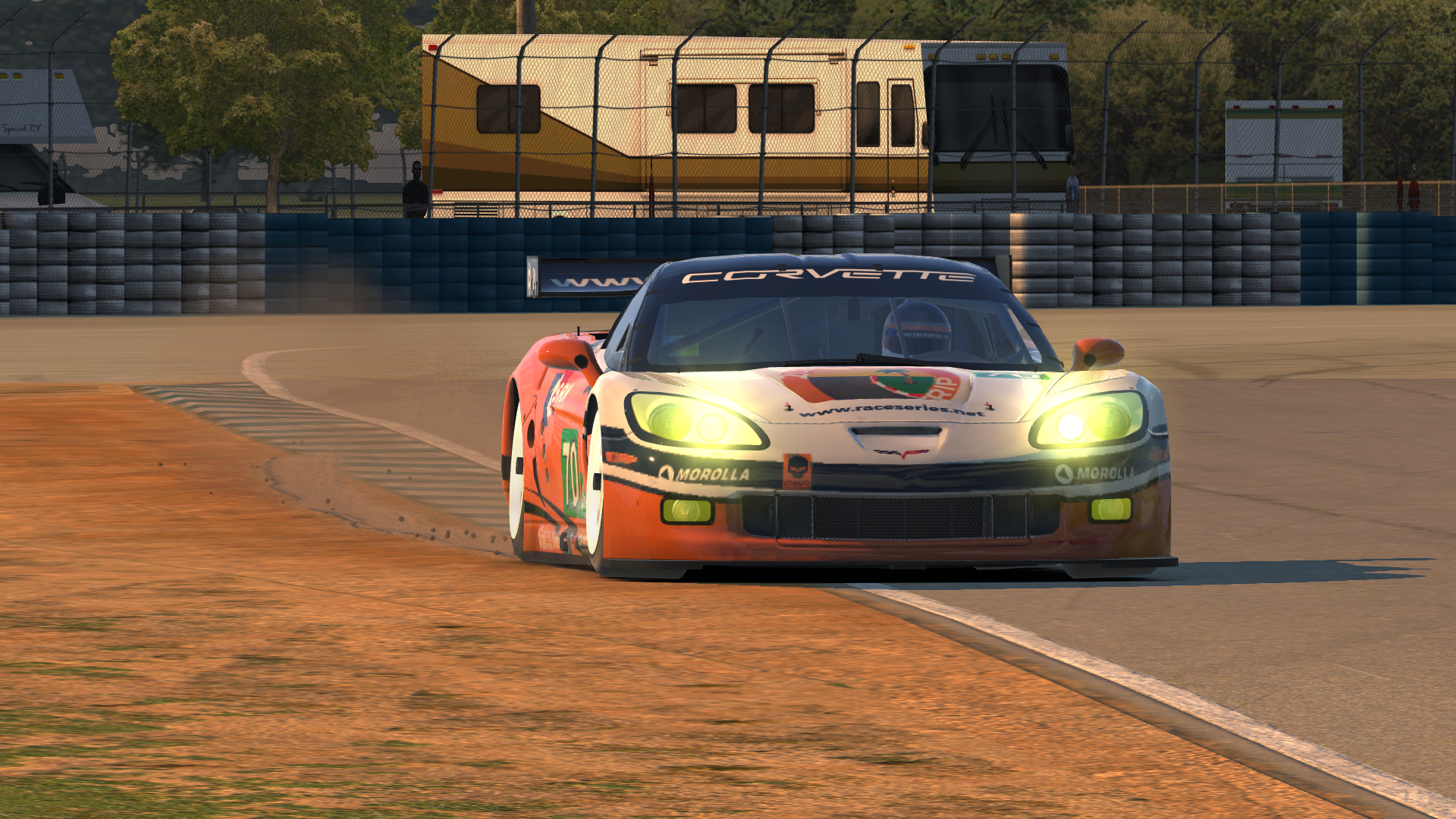
Kicking up dirt in the Corvette at Sebring.
Also, this isn’t an ideal pairing of cars. The Riley DP isn’t much faster than the GT1s, and it might prove to be an even more troublesome pairing than the current IMSA series, where slow Corvette Daytona Prototype drivers often get in the way of the GTE field.
And if the GT1s and GT2 are out of date, the Riley is doubly so — even its replacement has now been pushed aside by the real-world DPi class. Regardless of whether it’s a free car, will anyone want to drive something that old when far newer prototype options are available?
A final option I saw suggested is to restrict when this car can be raced, either by rotating the GT Challenge series with other less popular series from season to season or by offering fewer time slots to race during the week.
Both of these are based on the principle of supply and demand, but they also miss some key factors at play on iRacing. The former idea wrongly assumes that these less popular series share the same core group of drivers who would happily rotate between them.
The latter solution has been tried before, and it wasn’t a solution at all. Series with low participation could no longer decide which race days and times were best for its drivers, and if enough people wanted to race during an unavailable time slot, they could just create leagues or hosted sessions to fill the void.
A Simple Suggestion
I’m sure I probably sound overly pessimistic by shooting down most of these ideas, and I certainly don’t think I have all the answers. However, I believe the first step toward a solution is something that few people have mentioned.
In my experience, the number one determining factor in the health of a small series is the organization of its community. Even a few drivers banding together to organize one official time slot per week can be enough to keep a series alive, if only barely.
From there, as long as it has a pulse, it can be revived. This could be done through advertising — posting elsewhere on the iRacing forums or social media about that official race and recruiting new drivers to join.
Some clever branding might help, too. Several small series I’ve encountered have added features like classic paint schemes and custom championships to help bring the community together and encourage ongoing participation.
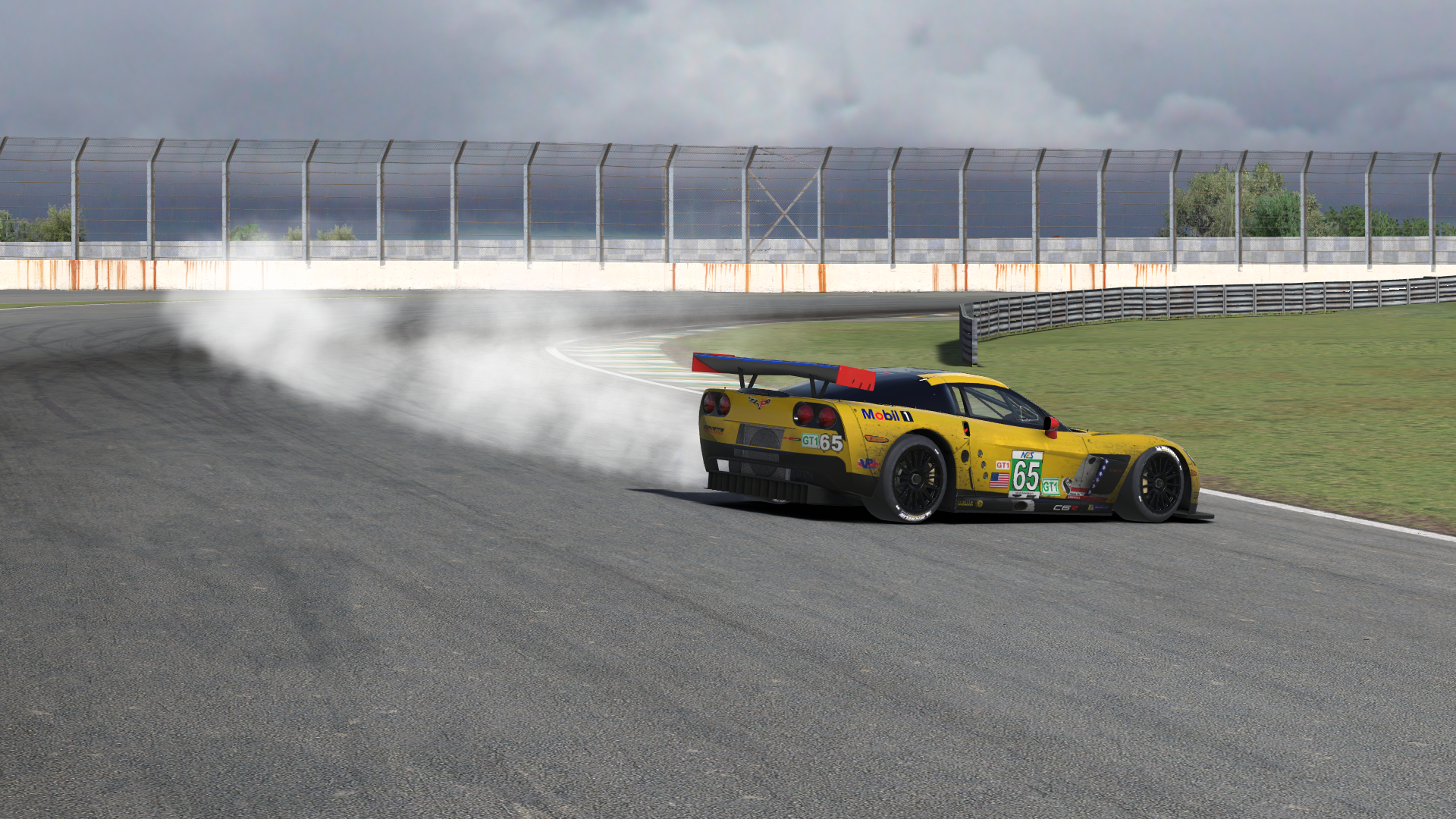
The Corvette and the rest of the GT Challenge series have skidded to a stop.
While none of those are necessities, that sort of window-dressing can make a difference. Potential drivers that see empty servers and no activity among the community don’t need to be asked twice to drive elsewhere. For that matter, I had this series on my schedule since the start of the summer and even I started to consider other options when it seemed that there was a strong chance of having no official races all week.
Once a struggling series shows some signs of life, iRacing may also take notice and give that series a platform during week 13 to interest new drivers. That once worked to introduce me to the asphalt sprint car, and in the following season, I became a series regular.
The sprint car series along with several others are proof that even with cars that aren’t the most modern or easy to drive, a bit of initiative on the part of a few people can be contagious. My suggestion for the Fanatec GT Challenge series is for even one person to try scheduling one official race per week. The worst that could happen is nobody showing up, which is no different than the current situation in which no one is coordinating — or even begging — people to join any races.
If it’s going to survive, this series needs a champion, but with the way things are going both on the track and in the community, there simply may be no one who qualifies in either realm.